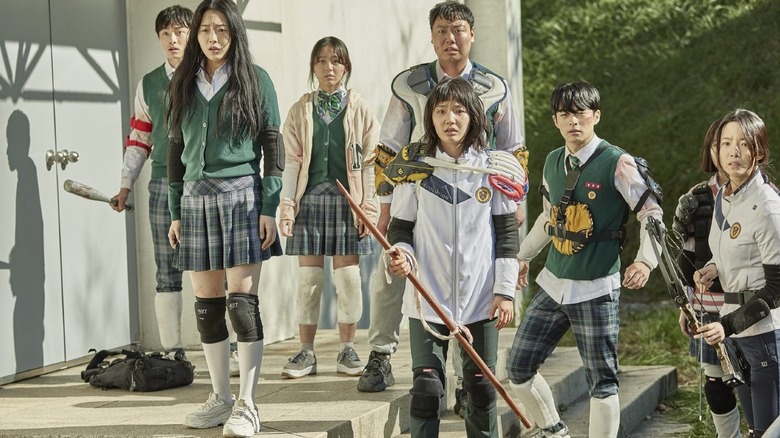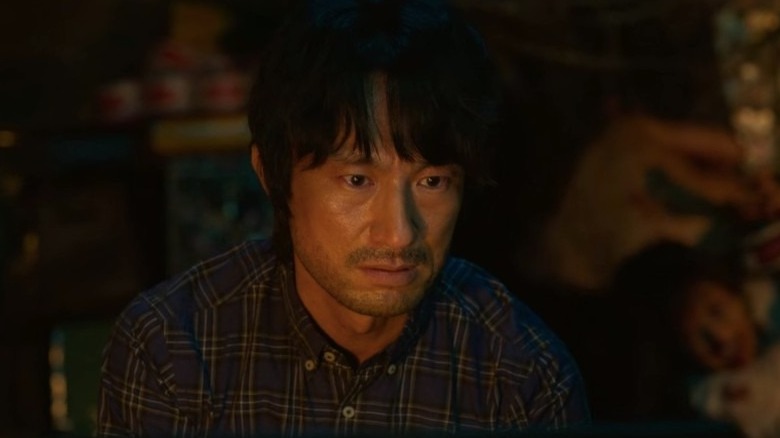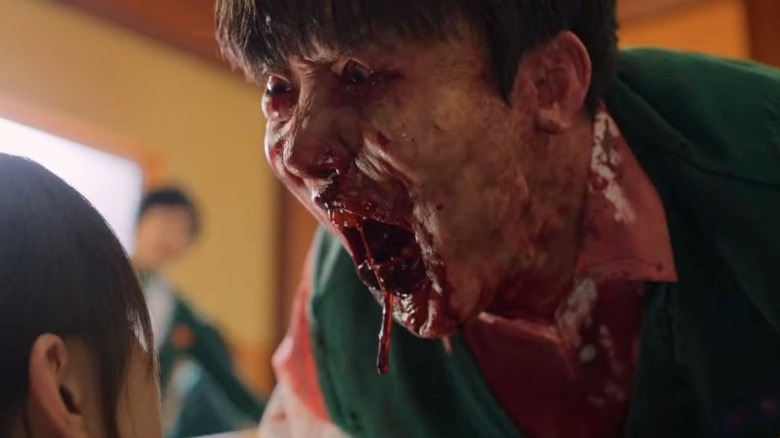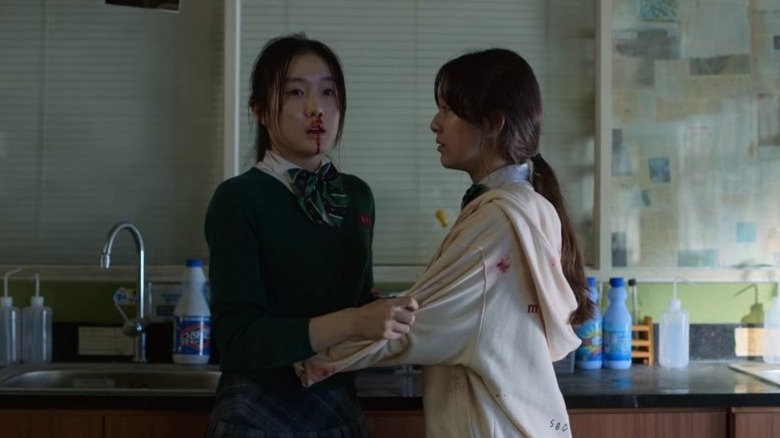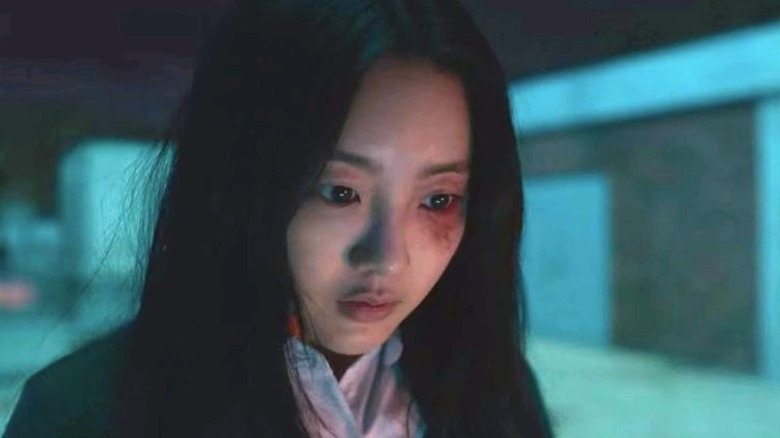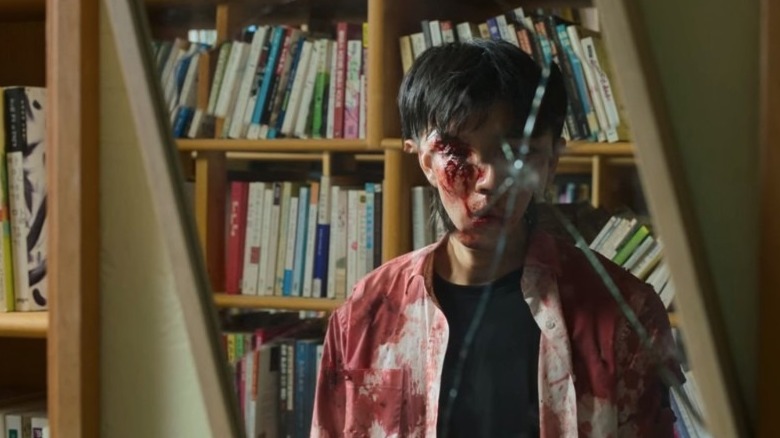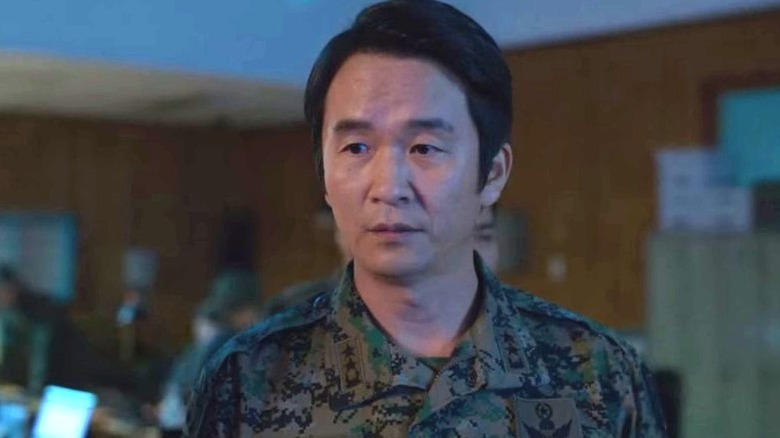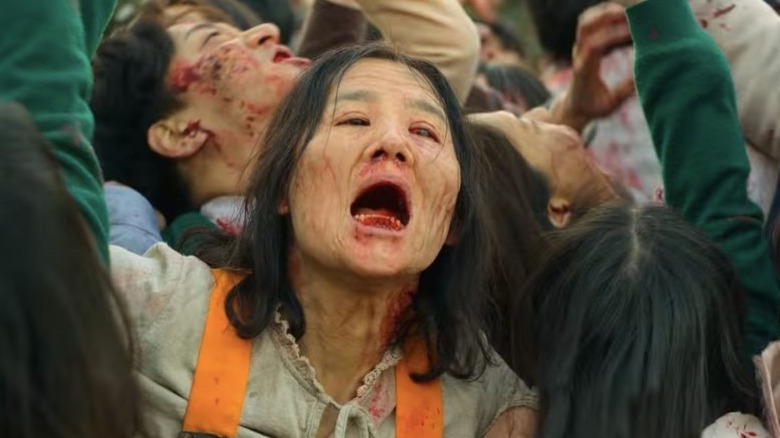Everything You Need To Know About The Zombies In All Of Us Are Dead
"All of Us Are Dead" is one of the year's best cinematic-level treats. There's a reason it set an important streaming milestone earlier this year. The South Korean zombie drama by Chun Sung-il, Lee Jae-kyoo, and Kim Nam-su packs in adrenaline-fueled action sequences that keep audiences on the edge of their seat. Sequences of blood, guts, and gore abound, and there's never an episode that doesn't deliver on all fronts, but the show is far more than that. It has heart, and you root for every character. It never plays it safe, and that should be commended.
With Season 2 a sure bet, there is great promise and opportunity for the story and the surviving characters going forward. There's surprising potential for the show's brand of zombies as well, with the show's human-zombie hybrids indicating there is a far bigger design at work. Ahead of the new season, we revisit "All of Us Are Dead" and walk through everything you need to know about the zombies from characteristics to a possible cure. Dig in below.
Origin story
Few zombie films and TV shows give such a detailed and emotionally-weighted backstory to their monsters as "All of Us Are Dead." Hyosan High School science teacher Lee Byeong-chan (Byeong-cheol Kim) worries greatly about his son being bullied and laments how Lee Jin-su (Lee Min-goo) doesn't have the courage to fight back. He has tried everything and wracks his brain on what to do next.
Drawing from his science background, his solution lies in creating a virus he dubs the Jonas Virus. The first test subject is a caged rat in his classroom, and the virus appears to give the specimen greater strength and sensory control. It is exactly what his son needs, so he injects Jin-su with the elixir. The results are less than desirable. Byeong-san documents each stage of the transition from the first dose to symptoms on his laptop, which becomes a key plot point in the series.
Efforts to distill his son's rage into ferocious resilience create the perfect storm for a deadly apocalyptic disease. Byeong-chan's son and wife succumb to the virus and turn into sub-human, flesh-eating rotters. One afternoon, another student gets bitten by the rat and ultimately meets the same tragic fate after being transported to the local hospital, and the outbreak begins.
Zombie characteristics
In the show's premiere episode, Jin-su is bullied atop a rooftop in downtown Hyosan and begins to experience severe zombie-like symptoms, including body contortion and animalistic aggression. His enemies attempt to fight back but quickly toss Jin-su over the ledge — seemingly to his death on the street below. But he doesn't die.
One of the main physical traits of zombies is the ability to endure injuries that would kill a normal human being. Throughout the series, resident antagonist Gwi-nam (Yoo In-soo) becomes a human-zombie hybrid (or "halfbie") and is thrown from towering buildings over and over again. The zombies do receive noticeable damage such as scrapes and gushing open wounds, but that rarely deters them from continuing to attack and spread the virus.
Jerky motor functions are just scratching the surface. Zombies experience blurred vision, so reliance on hearing and smell is crucial for their movement. Heightened senses result in nearly superhuman abilities. For example, when Su-hyeok (Park Solomon), Nam-ra (Cho Yi-hyun), and the rest of the group attempt to navigate through one of the school's corridors, they use the intercom system to blast music as a distraction. Plus, the zombies typically travel in large hordes, exhibiting a hive mind sensibility. Their sensory strengths also become their most crucial Achilles heel.
Getting infected
Jonas Virus infection largely comes through open wounds. The virus is not an airborne contagion and can only be transmitted through direct blood contact. Many characters are bitten in the show, including Cheong-san (Chan-Young Yoon) and Nam-ra. The location of bites varies greatly from person to person. Amputation does not halt the spread of the infection.
That said, the virus can also be transferred by wiping zombie blood on a fresh flesh wound. Episode 3 of the first season features one of the show's most horrific deaths involving Cheong-san's best friend Gyeong-su (Ham Sung-min). After a skirmish with a zombie, classmate Na-yeon (Lee Yoo-mi) claims one of Gyeong-su's scrapes resulted from a zombie bite (which just isn't true). When she gets the chance, Na-yeone takes a cloth, wipes the bloody end of a spear, and approaches Gyeong-su who is quarantined in another classroom. Cruelly, she drags the bloodied cloth across his wound. Moments later, he turns and hurls himself from the building.
This is a refreshing complication to zombie lore. Typically, zombie stories don't involve such an easy transmission of a deadly virus. Once infected, symptoms include a severely decreased temperature, bloody nose, and fractured mental faculties.
Halfbies: The good ones
One of the most fascinating aspects of the show is its expansion of the zombie mythos. When Nam-ra reveals she has been bitten in Episode 6, the group debates whether she's a threat or not. She struggles with symptoms, predominantly a hunger for flesh, but holds onto humanity enough to suppress those primal urges. Halfbies cannot be detected by regular zombies and are capable of calculated moves. They also have increased physical strength and heightened senses.
The halfbie is a compelling metaphor for holding onto a moral code in an apocalypse. The viral mutation could be the key to saving humanity, as an army of halfbies revealed in the Season 1 finale would be able to combat full-blown zombies. Fortunately, Nam-ra proves to be one of the good ones and often goes head-to-head with Gwi-nam, a far more evil halfbie. She is a formidable opponent. That's for sure.
The third halfbie in the show is Eun-ji (Oh Hye-soo) who straddles the line between good and evil. Once an assault victim, she finds courage to live fearlessly with her new-found strength and sensory powers. She tracks down those who never believed her about the abuse in the before-times, bringing into question ethics and what lines to never cross. Unfortunately, that comes at the cost of her humanity.
Halfbies: The bad ones
As mentioned, Eun-ji works both for the greater good and for further destruction. She's the consummate antihero in the show. She first hunts down the school counselor, to whom she expressed deep pain about being bullied, and delivers an epic comeuppance. She then sets one of the Hyosan High classrooms ablaze in a symbolic move to destroy the place that caused her to lose herself.
Her best friend, Chul-soo (Ahn Ji-ho), abandons her when she descends into the high school from the rooftop to retrieve incriminating evidence about her abuse. And she doesn't let it go, either. In Episode 9, the two reunite in the army's quarantine zone, and she exacts her revenge. Eun-ji brutally attacks him right out in the open. It's a morally ambiguous moment. Perhaps he deserves such a fate, but it does complicate matters. Heading into Season 2, Eun-ji is a wild card. She could go either way in the future.
Of course, the big baddie is Gwi-nam, who spends the entire first season on a revenge mission to find and kill Cheong-san. His emotionally-driven actions result in numerous senseless deaths, including that of Woo-jin (Son Sang-yeon), ultimately Cheong-san, and even Na-yeon (before her needed redemption arc). He causes chaos for the hell of it, and that creates heart-pounding tension.
The cure
A central plot point in Season 1 follows the search for Byeong-chan's laptop, located somewhere inside a classroom in Hyosan High. Detective Song Jae-ik (Kyoo-hyung Lee), live streamer Orangibberish (Lee Si-hoon), and policeman Jeon Ho-chul (Park Jae-Chul) are key players in the revelation and eventual retrieval of the highly-classified information.
Upon being detained by the military, Jae-ik shares the truth about the laptop that allegedly contains a cure for the virus. Cmdr. Jin Seon-moo (Rich Ting) stages an expedition to find the laptop and sends a group of armed military men in a helicopter to the high school. Once there, they scale the building and creep through various classrooms. Eventually, they find what they're looking for.
Back at base, Seon-moo sifts through various documents and video files and stumbles upon a clip of Byeong-chan revealing the cure. It's a simple, but frustrating admission: the only cure is the total eradication of the infected. The military first corrals the remaining zombies and then bombs important buildings throughout the city. Any straggling survivors are then required to live within the quarantine zone until the infection has been eliminated. In the Season 1 finale, it appears the zombie apocalypse is short-lived, but we all know better. It won't stay quiet for long.
Place in zombie history
"All of Us Are Dead" sets itself apart from most onscreen depictions of zombies while still embracing genre conventions and expectations. The halfbie mutation is particularly noteworthy, as typically in these stories, the infected are doomed and have no possibility of survival. As suggested by Nam-ra and the group of halfbies lurking in the Hyosan shadows, it's highly promising that the show will dig further into its zombie mythos.
Where do these zombies land in horror history? Well, they are not of the "Night of the Living" variety (slow walkers). "All of Us Are Dead" follows the example of such landmark films as "World War Z" and "Train to Busan" as well as the Netflix series "Black Summer." In all three cases, the zombies are relentless, almost mechanical, forces of nature that possess ungodly strength and speed. Additionally, there is a rich emotional layer to all four worlds that gives the flesh-eating and violence a much bigger impact.
